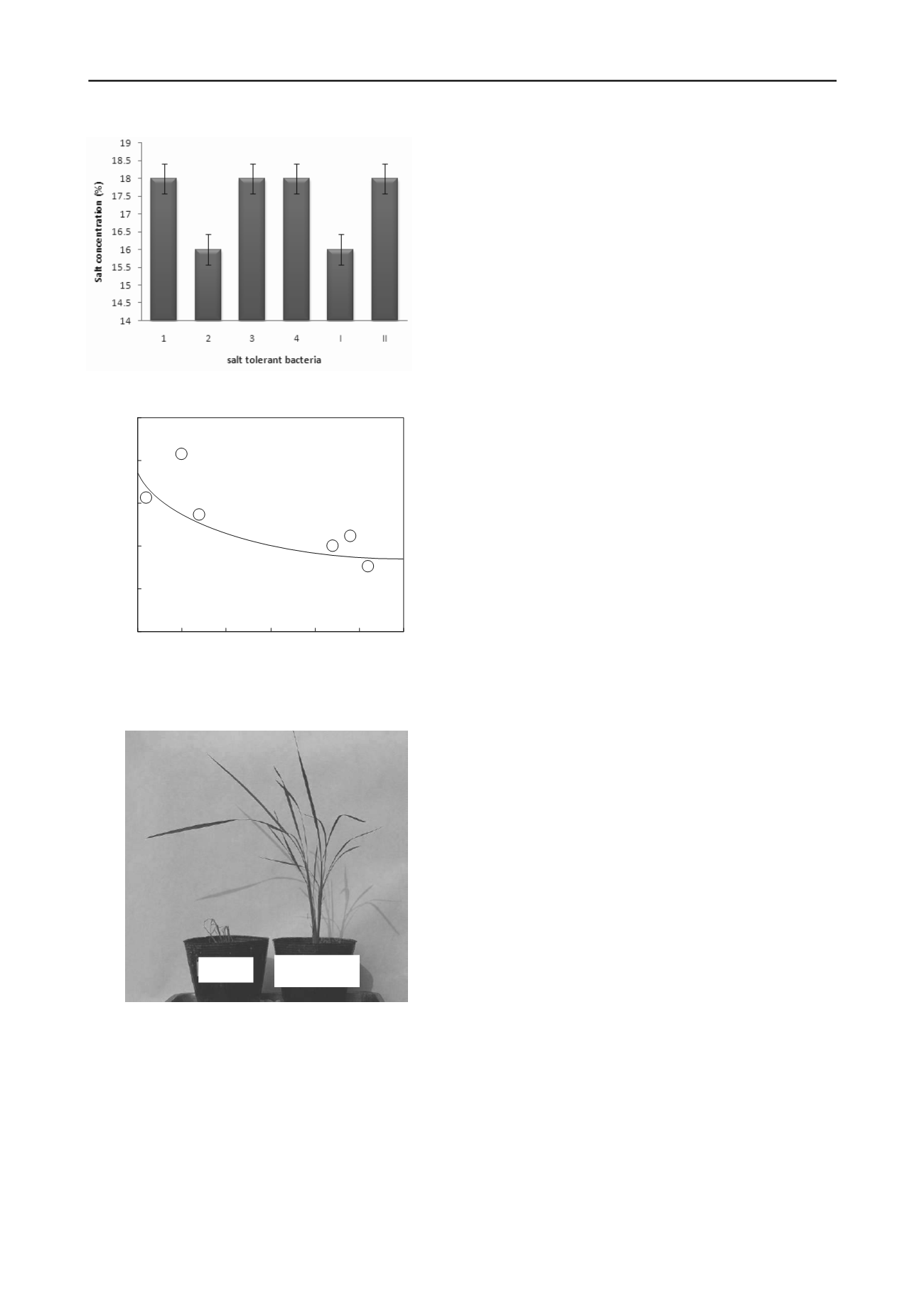
3060
Proceedings of the 18
th
International Conference on Soil Mechanics and Geotechnical Engineering, Paris 2013
Figure 9. Result of salt tolerance test on the compost
0.5
1
1.5
2
2.5
3
0
5
10
15 20 25 30
Curing period (day)
EC (mS/cm)
Figure 10. Relationship between electric conductivity and curing period
on soil with salt
Mixing of
the compost
Control
Figure 11. Result of potting cultivation test for rice plants
4.3
Laboratory tests of Saline Soil
In order to confirm the effect of the compost with salt tolerance
bacteria, laboratory tests of the saline soil were performed.
For making clear the effect, natural salt of 400mg/100g-dry
soil was added to a soil sampled from agricultural field at
Rikuzentakata city. The compost of 1g and rice bran of 10 g
ware mixed with the soil of 330 g. Electric conductivity of the
sample were measured continuously as shown in Fig.10. The
value of EC decreases with increase in curing period and
becomes almost a half after one month.
The farmers in Rikuzentakata city are not able to start a
cultivation of rice, because the agricultural land has contained a
large size of disaster wastes in the soil still now and tractor
cannot work correctly.
It was therefore that the potting cultivation test for rice plants
was conducted. Figure 11 shows the test result after one month.
In the case of control without the compost, rice plants were died
during one week. On the other hand, the plants using the
compost have grown steadily.
Thus, the compost with salt tolerance bacteria can reduce the
soil salinity and it is also confirmed that the compost is effective
for growth of rice plants and restoration of agricultural land.
5 CONCLUSIONS
The mega earthquake and consequent huge tsunami has done a
great damage to the entire areas of the pacific regions in Tohoku,
Japan. The sea water that overflowed the agricultural lands in
the area has created a critical situation for the farmers. The
farmers lost not only the crops they were cultivating but also the
soil of the agricultural field was seriously damaged by salinity
and other pollutants. The pH and EC of the soil have increased
and exceeded the safer limit for cultivated crops.
The compost containing salt tolerance bacteria was used at
the agricultural land damaged by Tsunami for restoration of the
saline soil. However, it was not easy to distinguish the effect of
the compost with salt tolerance bacteria clearly due to decrease
of salt concentration by rail fall and vegetation. The laboratory
tests of chemical properties and potting cultivation were also
performed on the saline soil. From the test results, the compost
containing salt tolerance bacteria can reduce the excessive salts
from the soil and consequently reduced the salinity problem. It
was also confirmed that the compost is effective for growth of
rice plants. The compost also provided necessary nutrients to
the soil and plant.
6 ACKNOWLEDGEMENTS
The authors wish to acknowledge the financial support by
Grant-in-Aid for Scientific Research (21360227, 23656299)
from Japan Society for the Promotion of Science and JST
revitalization promotion program (A-step) (241FT0057). The
authors also wish to thank Mr. T. Hashimoto for his valuable
help in the experiments and Cheering group of Ganbappeshi
Fukuoka.
7 REFERENCES
Bourgeois J, Hansen TA, Wiberg PL and Kauffman EG. 1988. A
tsunami deposit at the Cretaceous-Tertiary boundary in Texas.
Science, Vol. 241, 567-570.
Morton R.A., Gelfenbaum G. and Jaffe B.E. 2007. Physical criteria for
distinguishing sandy tsunami and storm deposits using modern
examples. Sedimentary Geology, 200, 184-207.
Minoura K., Gusiakov V.G., Kurbatov A., Takeuti S., Svendsen J.I.,
Bondevik S., Od, T. 1996. Tsunami sedimentation associated with
the 1923 kamchatka earthquake. Sedimentary Geology, 106, 145-
154.
Nishimura Y. and Miyaji N. 1995. Tsunami deposits from the 1993
Southwest Hokkaido earthquake and the 1640 Hokkaido
Komagatake eruption, northern Japan, Pure and Applied
Geophysics. 144 (3-4), 719-733.
Omine K., Fujikawa T., Sugimoto S. and Maeda H. 2012. Investigation
of Rikuzentakata city of Iwate prefecture and geo-environmental
Approach - Ground settlement, waste materials and restoration of
saline agricultural land -, Japanese Geotechnical Journal, 7 (1), 231-
241 (in Japanese).
Shiki T. and Yamazaki T. 1996. Tsunami-induced conglomerates in
Miocene upper bathyal deposits, Chiba Peninsula, Central Japan.
Sedimentary Geology, 104, 175-188.


